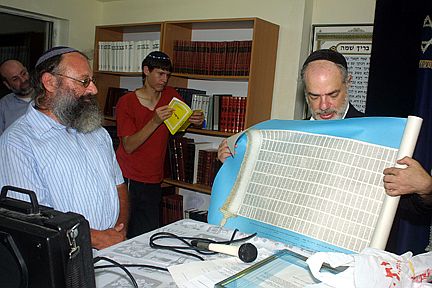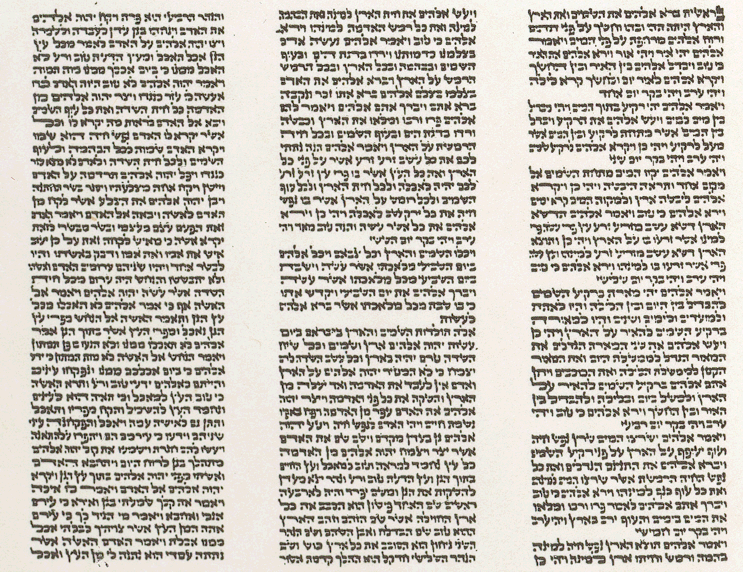
Sponsors of a Parshat HaShevua for $200 or more will receive a framable Sefer Torah Poster which they can hang in their home, or give as a gift. Contact this author at: olehchadash@yahoo.com for more details.

Israel and The Sin of Expulsion
The Implications and Consequences of Expulsion for the Jewish People

Sponsors of a Parshat HaShevua for $200 or more will receive a framable Sefer Torah Poster which they can hang in their home, or give as a gift. Contact this author at: olehchadash@yahoo.com for more details.

Rashi asks a critical question on the very first posukim of our Parsha:
“Hashem spoke to Moshe on Har Sinai, saying: Speak to the B’nai Yisrael, and say to them: When you come to the land which I give you, then shall the land keep a Shabbat to Hashem.” (Parsha Behar, Vayikra Perek 25, posukim 1 & 2)
Rashi asks why the laws of Shemittoh are singled out as having been given at Sinai. Were not all of the Mitzvot said at Sinai?” He answers that just as all of the Mitzvot; their general rules and their specifics were taught at Sinai, so too were the general rules and specifics regarding Shemittoh taught at Sinai. Rashi then reasons that the posuk comes to teach us that every utterance said to Moshe, they were all from Sinai. (Rashi on Parsha Behar, Vayikra Perek 25, posuk 1)
The positioning in Torah of our Parsha Emor, following last week’s Parsha Kedoshim gives rise to thought and contemplation. In the previous 2 twin Parshas; Acharei Mos and Kedoshim, and Tazria and Metzora before them, we learn about the Kohen as the only one Divinely invested with ruling as to Tumah or Ta’Hara regarding ones’ skin, hair, clothing or homes as well as with being the vehicle for Yom Kippur avodah in the Kadosh Kedoshim and as the model, the paradigm of the Darchim for the entire B’nai Yisrael to emulate as a model for all mankind.
Parshiyot Acharei Mos and Kedoshim are normally what baseball fans refer to as another of the “doubleheader” parshiyot. And just as Parshiyot Tazria and Metzora are extensions of each other, visa vi Tumah and Ta’Hara regarding post-birth, regarding skin, hair, clothing or regarding one’s home or building; Acharei Mos and Kedoshim are extensions of each other regarding Kohanim, Yom Kippur, the Kohen’s Yom Kippur avodah in the Kodosh Kedoshim and the Kohanic model of Darchim, which ideally the entire B’nai Yisrael would embrace and exhibit as a paradigm, as model, as a light for all mankind.
In learning about the laws of tzara’as, we find posukim which are a pelah, a wonderment.
Torah relates in Parsha Tazria;
“If the tzara’as will erupt on the skin, and … will cover the entire skin of the afflicted from his head to his feet, wherever the eyes of the Kohen can see — the Kohen shall look, and behold! — the affliction has covered his entire flesh, then he shall declare the affliction to be pure; having turned completely white, it is pure. On the day healthy skin appears …, it (the affliction) shall be contaminated.” (Sefer Vayikra, Perek 13, posukim 12 – 14)
After learning in Parsha Tzav that for seven days, Moshe taught Aaron HaKohen and his sons the laws of their Avodah (the Kohanic Service, i.e. in the Tabernacle and later in the Beit HaMikdash — ” The Temple”) in the Mishkan, our Parsha Shemini begins by relating that on the eighth day, Aaron and his sons commenced their Avodah HaKodosh (Holy Service). It is interesting and ironic that our parsha is the other side of the term; “Tzav-Shemonah” which is the document or order issued by the Israel Defense Forces calling reservists to active duty in event of war.
Shalom and Chag Same’ach Friends;
This Author has been very into R’ Shimson Rafael Hirsch z”l as is evident from citings from the new Hirsch Chumash (published by Feldheim in 2005 and translated to English by Rabbi Daniel Haberman) included my various Parshiyot HaShavua’s. Have also been learning R’ Hirsch’s “Nineteen Letters”, translated with commentary by Rabbi Joseph Elias. There are some passages from the text of Letters # 8 and 9 of “Nineteen Letters”, as well as commentary on the letters which seem to speak loudly in contributing to an ADULT’s focus in Being and Feeling as if “There” — being with the rest of Am Yisrael in Mtizrayim, feeling their pain of persecution and enslavement, as well as their euphoria upon Yetizot Mitzrayim.
This year will mark seventeen years, and my fourteenth Pesach in Eretz Yisrael, in which I have emailed, as it has become tradition with me from prior to my Aliyah, the rendition of Dayenu quoted from the book “Dear Brothers.” In each year, Dayenu holds a unique perspective, unlike the perspective of any previous year.
Each year, this author tries to put forth factors that relate to the state of B’nai Yisrael — right here and right now.
And so, the lessons of Dayenu are vital now, just as they were in the first year that I emailed this vort out or, for that matter, as vital as they were when it was quoted in Segal’s compilation of the book in its copyright year 1988.
In our Parsha, Tzav is Moshe’s command from Hashem to Aaron HaKohen and his sons to take up and clothe themselves in their Vestments, their garments of service in the Mishkan, and to begin their daily Avodah (service and offerings in the Mishkan).
For seven days, Moshe taught Aaron HaKohen and his sons the laws of their Avodah in the Mishkan. (You might say that they were given, as they term it in the US, OJT from Shemayim.) On the eighth day, Aaron and his sons began their Avodah.
The first word of our parsha; Vayikra is the source of much discussion as to why the word ends with a small “aleph” and tells much about Moshe Rabbeinu’s level of principle, integrity and his standard of leadership of B’nei Yisrael. R’ Shimshon Rafael Hirsch, z’l in the new Hirsch Chumash (published by Feldheim in 2005 and translated to English by Rabbi Daniel Haberman) renders translation of our Parsha’s opening posuk:
“And He called to Moshe, and Hashem spoke to him from the Tent of Appointed Meeting [Mei-Ohel Mo’ed], saying:” (Hirsch Chumash, Sefer Vayikra, page 1, Perek 1, posuk 1)